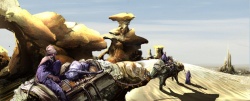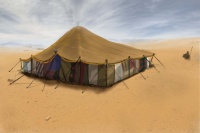Iwu Koraha Mahue is the name for a gathering of several dozen tribes in the Central Desert region of the Milil’ea continent on Harakoa. It is a loose conglomerate of farmers, merchants, miners and warriors that work as separate entities, but gather under a unified banner in times of hardship. Iwu Koraha Mahue is loosely translated as People of the forgotten desert.
History
Prehistory/Antiquity
 Nomad merchants
Nomad merchants
The Harakoans of the Central Desert never truly migrated to that region. The desert was a lush grassy plain in ages past and the Korahaii adapted to the environment during the gradual changes. Why they stayed is still a mystery, but some Jedi archeologists believe it is due to their sacred ritual site which appears to have been the same thousands of years ago. There is little-to-no evidence of this however and scarce artifacts dug out from the desert sands reveal no more than is already known.
Last Centuries
It was only during the last millennium that the many tribes Korahaii gathered into a single entity. When exactly it happened remains unknown but tradition states that after a long conflict between the tribes, all chief gathered under one tent and agreed to share all that they owned. This theory is highly unlikely, however. It is more likely that the tribes gradually moved towards a symbiotic lifestyle over centuries.
Another theory, albeit controversial, seems to have take root with some of the Jedi. During the century before the unification, one of the many tribes discovered a way to mine and process copper. Due to the jump in technology, this tribe took a leadership role and gradually subjugated the others under their rule. As centuries passed by the bond that held them together loosened and what was left was the current order.
After arrival of Jedi
It was only after the re-taking of Harakoa that the tribes were truly discovered, though several prior reports indicated that Harakoans did live in the Central Desert. It was Jedi Scholar V'yr Vorsa who found the tribes fascinating and note-worthy, due to their resilience to the burning heat and dry desert conditions. She had been studying them from afar long before she went to greet them. It was in the tent of Tā-Raumati Matua, the de facto leader of the Korahaii, that she was welcomed as an honored guest and given the great honor of becoming the Jedi ambassador. She was named Whakarauora, which means Survivor in Korahose, reflecting Vorsa's natural resilience which the tribesmen found fascinating. After the formation of the Korahaii militia as part of the K.U.D.F., Vorsa was also named "Toiora ne'Taika", loosely translated to "Roaring Tigress", reflecting her military prowess and leadership of the tribe's warriors.
Geography
The desert is mostly comprised of dunes of loose sand, but several areas consist of rocky plains or hills with scarce vegetation and watering holes. To the west the desert borders with a massive mountain chain while to the east it gradually turns into grassy plains and swamps. To the north it meets the great ocean, while in the south the freezing weather turns it into a perilous tundra.
Climate
The climate of this region is uncomfortably hot and arid. Though the tribes of the desert have grown accustomed to it, most travelers and visitors tend to endure many health problems. Acclimatization to the weather is hard and long, but once acclimated, one can travel the desert with little fear of the elements.
During the day temperatures skyrocket to 50 degrees standard, while during the night they can plummet below freezing. Winds are a major obstacle while traveling, since freak tornadoes and dust devils are frequent.
Biome
 Nomad traveling on a Mokaikai
Nomad traveling on a Mokaikai
Anything and everything that lives in the desert is both very adaptable and water-conserving. Many plants that live in the desert proper have natural mechanisms for gathering moisture and conserving it, much like the moisture-gatherers of Tatooine. Travelers use these plants to replenish their water supply. Other plants live near watering holes, creating lush green dots on a very barren landscape.
Many animals that live in the desert aren't bigger than a common pet, but some like the Mōkaikai, a creature similar to the Tatooinian Dewback, live and thrive in this environment.
Territory
The tribes cover a wide area of the desert, from the West to the East and even into the Tundra. They have no permanent residence, though ancient ruins have been found in the desert. They are mostly nomads who travel with the seasons and in search for tradable goods and food. Their territory is at times as small as the Colonies on Owyhyee or as big as the whole Central Desert.
Inamata Toma
 Inamata Toma
Inamata Toma
Inamata Toma is an ancient Harakose name for the ruins of a civilization that pre-dates the current tribes by several millennia. It roughly translates to Ancient tombs. Located in the Western desert, near the massive mountain ranges, it is a mystery still being uncovered by Jedi archeologists. Many artifacts were dug out of the ruins, confirming the notion that copper and bronze were used on Milil’ea long before the Korahaii discovered them.
The ruins are made from rough limestone, but it is believed the outer surfaces were covered by a more polished white limestone found in the mountains. While they are monumental structures, the millennia of rough winds and desert sands have reduced them to near-indistinguishable stone formations. Many archeologists believe much of the structures is still hidden beneath that sands and that they will be uncovered in the coming decades.
Structure
 A traditional Korahaii tent
A traditional Korahaii tent
Each tribe of the Korahaii people have their own priests and chief. Though they are all essentially the same people, their traditions and places of worship may vary from tribe to tribe. Chiefs are often the wiser and older members of the tribes, the ones who have lived a lifetime in the desert and know it's nooks and crannies well.
Chieftain
It is the duty of the chief of each tribe to advise his people, plan travel routes, manage the tight schedule and keep everyone "on the same track", as it were. They are not so much an authoritarian position as one of coordination. Most chiefs are considered to be fathers to their people, thus the name Matua which in ancient Harakose means chief, or father.
Tā-Raumati Matua (which loosely translates to Chief Summer-Wind, or just Summer-Wind) is the eldest and wisest of the chiefs, acting more as an adviser to his younger compatriots, rather than being an actual king or leader.
Military
The Korahaii have a proud warrior tradition even though full scale wars are rare. All of the weapons that the Korahaii use are bronze. The more decorated the weapon the higher one's status or wealth. Some weapons are known to be passed through the generations as family heirlooms as well.
Tribal wars are very rare, but when they do occur, they are either negotiated or resolved through single combat much like smaller disputes. It is very rare for whole tribes to go to war, but it ahs occurred in the past and may occur in the future as well.
Law
Most crimes are punishable by community service or downright servitude for a period of time dictated by the chief. Local and domestic conflicts and bigger crimes are handled through ritualized single combat. Though it was once lethal, these days most chief have banned killings in duels due to the need for able hands. Some still hold to old traditions, however.
Religion
 Rauru-Pae
Rauru-Pae
The Korahaii ritualize and revere almost any creature they come upon in the desert and have a deep sense of belonging to the environment. The desert is their Ūkaipō, their Mother, and she provides or takes from them as she sees fit.
All Korahaii, regardless of tribe, have one specific place where they gather to give thanks to the desert for another year of their lives. It is called Rauru-Pae, or Mother's place, and it consists of a rocky hill on top of which the Korahaii of old have built altars and places of worship. Most priests lead their tribes on month-long journeys to Rauru-Pae so that all may give praise to their Mother.
Priests
Priests have no worldly powers, but they have a lot of influence on the people as their religious paragon. Priests often work with the chiefs to maintain order and discipline in the tribes. They are also well versed in medicines and poisons. They possess great knowledge about the flora and fauna of the desert and are considered great survivalists.
Commerce
Most commerce in the desert revolves around food, bronze, fine cloth and similar goods. The tribes trade with other Harakoans on the continent and receive wheat, wine, fruits, fish and other goods not readily available in the desert. The food trade consists of trading Mōkaikai meat, which is abundant, hardy, long-lasting and good with cheese.
Culture
Languages
While the Korahaii do speak Harakose, they do so in an ancient dialect very different from the ones the Jedi are used to. Understanding them is hard at best, and often requires hours and hours of study to master their language. This dialect is their trading language, used mostly for communication with other tribes in the region. However, they do use their own language while in the confines of their tents. This language still remains a mystery and will have to be studied further.
Music
Music is often the distraction of choice among the Korahaii. They sing and dance mostly during the night when they spend quality time with their family and friends. The instruments used are mostly string or drums made from animal leather and bones, however they have a peculiar sound not heard anywhere else. Music is also part of their rituals, both combat and religious.
Art
The Korahaii express their taste for art through their colorful clothing, weaponsmithing and their demeanor towards strangers. They consider hospitality a certain art form and have ritualized the process of smoking, drinking and even eating with strangers to a fine point. The weapons they use are labors of love and are often decorated with lavish designs to signify the wearer's importance. The same goes for clothes. the Korahaii have a love for fine and colorful clothing and often wear lavishly designed masks to cover their faces from the brutal winds of the desert.
Foreign Relations
Tythonians
So far no communication between the tribes and the Tythonians took place. The Korahaii receive their outside information from the Jedi who chose to stay with them.
House Odan-Urr
Apart from several Jedi archeologists and the ambassador, most Jedi focus on other endeavors and care little about the desert tribes. Tā-Raumati Matua, as the representative, has met with Councillor Torun on several occasions, mostly to broker trade deals. Slowly but surely the tribes are being acclimated to the notion of outside influence and are befriending the Jedi.